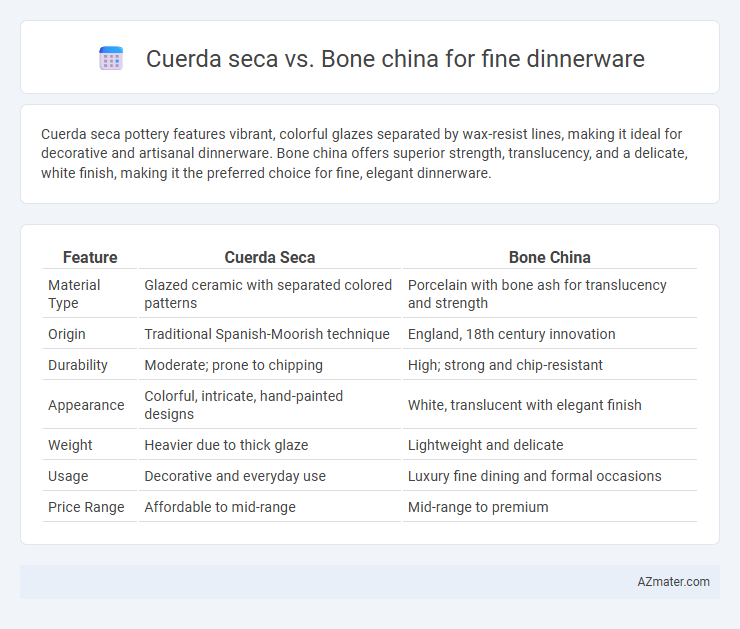Cuerda seca pottery features vibrant, colorful glazes separated by wax-resist lines, making it ideal for decorative and artisanal dinnerware. Bone china offers superior strength, translucency, and a delicate, white finish, making it the preferred choice for fine, elegant dinnerware.
Table of Comparison
| Feature | Cuerda Seca | Bone China |
|---|---|---|
| Material Type | Glazed ceramic with separated colored patterns | Porcelain with bone ash for translucency and strength |
| Origin | Traditional Spanish-Moorish technique | England, 18th century innovation |
| Durability | Moderate; prone to chipping | High; strong and chip-resistant |
| Appearance | Colorful, intricate, hand-painted designs | White, translucent with elegant finish |
| Weight | Heavier due to thick glaze | Lightweight and delicate |
| Usage | Decorative and everyday use | Luxury fine dining and formal occasions |
| Price Range | Affordable to mid-range | Mid-range to premium |
Introduction to Fine Dinnerware: Cuerda Seca vs Bone China
Cuerda seca and bone china represent two distinct approaches to fine dinnerware, each valued for its unique craftsmanship and aesthetic qualities. Cuerda seca features vibrant, hand-painted designs separated by thin lines of manganese oxide, resulting in durable, colorful ceramic pieces traditionally associated with Spanish and Mexican pottery. Bone china, composed of bone ash, feldspathic material, and kaolin, is renowned for its delicate translucency, strength, and smooth, white finish, often preferred in luxury table settings worldwide.
Historical Origins of Cuerda Seca and Bone China
Cuerda seca, a technique originating in 10th-century Islamic pottery, involves using greasy lines to separate colored glazes, creating intricate, multi-colored designs in ceramics. Bone china was developed in 18th-century England by combining bone ash, kaolin, and feldspar, resulting in a durable yet translucent porcelain prized for fine dinnerware. Both materials reflect their distinct cultural heritages, with cuerda seca emphasizing vibrant, historical ceramic artistry and bone china representing refined craftsmanship in Western porcelain manufacturing.
Distinctive Features and Techniques
Cuerda seca utilizes a resist technique with manganese oxide outlines to separate vibrant glazes, creating intricate, multicolored patterns on ceramic tiles or dinnerware, known for its rich historical roots in Spanish and Islamic art. Bone china, composed of bone ash, feldspathic material, and kaolin, is prized for its translucency, whiteness, and exceptional strength, offering a refined, delicate appearance while maintaining durability. The distinctive cuerda seca technique emphasizes intricate hand-painted designs and bold color contrasts, whereas bone china's key attributes lie in its lightweight, chip-resistant quality and smooth, polished finish.
Material Composition and Production Methods
Cuerda seca dinnerware utilizes a ceramic base coated with a waxy resist that prevents glaze colors from mixing during kiln firing, creating intricate designs with rich, textured surfaces. Bone china is composed primarily of bone ash, kaolin, and feldspar, resulting in a lightweight, translucent, and highly durable porcelain. The production of bone china involves precise high-temperature firing to achieve its strength and delicacy, while cuerda seca relies on layered glazes and wax resist techniques for its distinctive, colorful patterns.
Visual Appeal: Colors, Patterns, and Finish
Cuerda seca dinnerware features vibrant, hand-painted colors and intricate patterns achieved through a resist technique that creates sharp, contrasting designs with a matte or semi-matte finish. Bone china offers a translucent, smooth, and glossy finish with delicate, often floral or minimalist patterns that highlight its fine, porcelain-like elegance. The visual appeal of cuerda seca lies in its bold, artisanal aesthetics, while bone china emphasizes subtle sophistication and refined beauty.
Durability and Longevity Comparison
Bone china offers superior durability and longevity compared to cuerda seca due to its high calcium phosphate content, which makes it highly resistant to chipping and cracking. Cuerda seca, known for its intricate, hand-painted designs, is more fragile and prone to wear over time, especially with frequent use. For fine dinnerware intended for daily or long-term use, bone china provides a more resilient and lasting option.
Usability: Microwave, Dishwasher, and Everyday Use
Cuerda seca dinnerware, often crafted from earthenware or stoneware, generally lacks microwave safety due to its decorative metallic glazes, making it less ideal for everyday microwave use. Bone china dinnerware is prized for its durability, microwave safety, and resistance to chipping, allowing convenient dishwasher cleaning and suitability for daily use. While bone china excels in practicality, cuerda seca pieces are typically reserved for decorative or special occasions due to their delicate nature and limited microwave compatibility.
Cultural Significance and Popularity
Cuerda seca, a traditional Spanish-Moorish ceramic technique, holds significant cultural value, representing centuries of artisanal heritage and vibrant, intricate patterns that appeal to collectors and cultural enthusiasts. Bone china, originating in 18th-century England, is prized globally for its durability, translucency, and elegant white finish, making it a popular choice for fine dining and luxury tableware. While cuerda seca is celebrated for its artistic and historical importance, bone china dominates the fine dinnerware market due to its refined appearance and practical functionality.
Cost and Market Availability
Cuerda seca dinnerware typically costs less due to its traditional hand-painted techniques and limited mass production, making it more niche and harder to find in mainstream markets. Bone china offers a wider market availability with diverse price ranges, appealing to both budget and luxury consumers because of its durable, translucent quality and high demand in global fine dinnerware collections. When choosing between the two, buyers balance cuerda seca's artisanal rarity and cost against bone china's accessibility and broader market presence.
Choosing the Best: Which Is Right for Your Dining Table?
Cuerda seca and bone china are distinct options for fine dinnerware, each offering unique aesthetic and functional qualities. Cuerda seca, a traditional Spanish technique, creates intricate, colorful patterns sealed under a transparent glaze, ideal for adding vibrant, artistic flair to your dining table. Bone china, prized for its strength, translucency, and elegant white finish, suits formal settings seeking durability combined with refined simplicity.

Infographic: Cuerda seca vs Bone china for Fine Dinnerware
 azmater.com
azmater.com